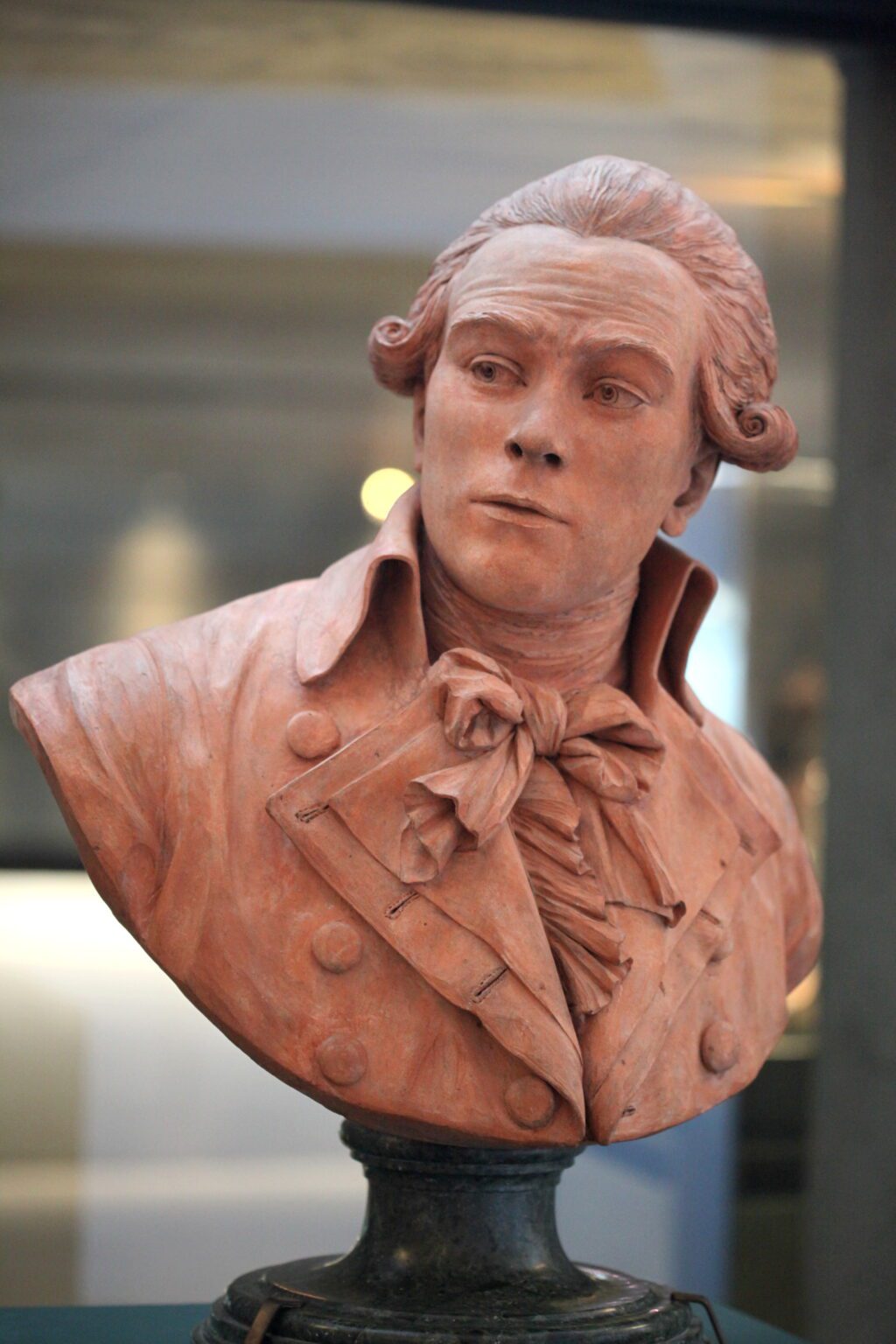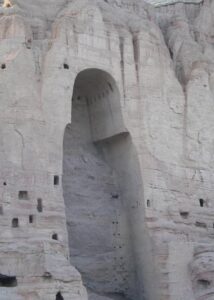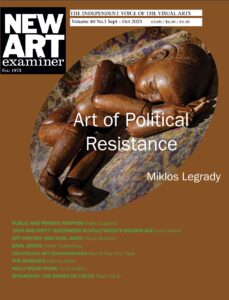
Terracotta bust of Robespierre by Deseine, 1791 Musée de la Revolution Franccaise
Partisanship tends to deceive the partisans. Although true believers may not admit it, some issues do transcend politics. Such is the case with an article that Roger Kimball published in The Wall Street Journal in December 2018.
In response to the appointment of Kaywin Feldman as director of the National Gallery of Art in Washington, D.C., Mr. Kimball, publisher and editor of the New Criterion, wrote an article titled “The National Gallery of Identity Politics.” The last sentence in the second paragraph of the piece states, “Today, many art museums serve as fronts in battles that have little or nothing to do with art: entertainment, yes; snobbery and money, of course; and politics, politics, politics.”1

Does Mr. Kimball have a point? The evidence suggests that in an effort to validate all viewpoints, experiences, and identities, the museum has increasingly become a political institution at the service of causes deemed to be on the “right side of history.” The dialectical tension that defined Western discourse since the Greeks has given way to totalizing inflexibility. Postmodernism not only destroyed the difference between perspectivism and relativism, it left no room for a “loyal opposition.”
Under postmodernism, perception not only overtook reality, it assumed a dominant position as the truth. Any criticism thereof became a heresy. In the process, it paved the way for a zero-sum culture of moral certainty and sociopolitical intransigence. As if to mock its rebellious birth, the counterculture degenerated into neo-puritanism while its protagonists rose through the ranks of educational and cultural institutions in order to implement the authoritarian policies that their ideology demanded. Zero-sum culture demands zero tolerance of anything that questions it. It uses cultural relativism to discredit connoisseurship, destroy canonical standards, and establish draconian rules that claim to be just and egalitarian. Therefore, the answer as to whether or not Mr. Kimball has a point must take into account his political position versus that of the reader. Roger Kimball is an avowed conservative. He is also an astute, articulate, and erudite intellectual and cultural critic whom self-professed progressives should heed; especially, since they are often the first victims of the new feel-good absolutism. His critique of Ms. Feldman is undeniably partisan, but his grasp of the canon and the dangers it faces should be taken seriously by anyone who loves art and values the very concept of civilization. In order to understand the implications of his argument, one should first revisit recent history.
In the spring of 2001, the Taliban destroyed the Buddhas of Bamiyan, Afghanistan. The giant statues offended the religious sensibilities of the Taliban. Throughout 2014 and 2015, the Islamic State of Iraq and the Levant destroyed mosques, churches, and ancient Babylonian, Assyrian, and Greco-Roman sites throughout Iraq and Syria that defied its deeply iconoclastic beliefs. Although the Western press covered the events, the reaction of the so-called art world was far from dramatic, and the general public was not particularly disturbed. Yes, there were outcries among some art historians and archeologists, but they could not compete with the silence of artists, curators, and critics.
It seemed that the tragic loss of irreplaceable artistic treasures was no match for the daily images of bombings, shootings, hangings, burnings, and decapitations. After all, human life was worth more than art. Unfortunately, that assumption was not entirely correct because the West was neither fully nor uniformly horrified unless the violence killed Westerners. Yet even that reality fell short of something far more ominous and nihilistic. The West was replacing its literary, philosophical, and artistic canons with relevance. Reason, objectivity, empiricism, tolerance, individual rights, free speech, representative democracy, and the rule of law were giving way to the dictatorship of feelings, subjectivity, relativism, moralistically driven intolerance, censorship, and the histrionics of Internet mobs. The grand narrative that united disparate elements throughout the West was surrendering to solipsistic micro-narratives of self-pity and resentment. The transcendent spirit that allowed the individual to relish tragedy as a shared heroic experience had degenerated into vulgar depression incapable of creativity. The inevitability of death no longer served to make life sweeter. Instead, it became an excuse for collective despondency within the medicated hive of digital nihilism. Under the circumstances, the destruction of a Middle Eastern legacy that belonged to all of humanity had little meaning for a Western cultural elite that no longer believed in the Enlightenment. To borrow from Goya: Reason slept, and its sleep produced monsters that threaten to make the Taliban and the Islamic State look like amateurs.
The pseudo-romantic revival of collective ignorance was reminiscent of the book burnings that took place in Germany in 1933. An atavistic frenzy of anti-intellectual self-righteousness had gripped the universities and threatened to overpower all the cultural institutions of the West. A cultural deskilling that recalled the Khmer Rouge could be seen in the humanities as grammar and syntax were deemed to be oppressive constructs while Shakespeare and Cervantes were dismissed as shills for European imperialism. Institutions of higher learning were becoming centers of cultivated ignorance, a point driven home when, at the end of a lecture on Velázquez, a sophomore at a prestigious American art school asked, “Didn’t you say that Velázquez was Spanish.” When the lecturer responded that Velázquez was indeed Spanish, the student asked, “Then how come all the people in the paintings are white?” It soon became clear that the student had no idea that Spain was in Europe or that the Spanish were Europeans. The lecturer soon learned that the student’s ignorance was all-too-common. Geography had ceased to be relevant.

What the Taliban had achieved with high explosives, Western cultural institutions were achieving through policies that would ensure the discreet obliteration of a civilization. The fact that it was done in the name of multiculturalism made it all the more cynical. True multiculturalism is not the same as zero-sum culture. Nor is it as good as cosmopolitanism. Unlike cosmopolit-anism, multiculturalism betrays its name and increasingly promotes the false notion that one culture can only exist at the expense of another. Whereas cosmopolitanism is expansive and genuinely inclusive, multiculturalism is provincial and exclusive. Its core is tribal and fearful of strangers. It cannot share itself. It is easily threatened. It can only exist in protected zones, so-called safe spaces, because it is too fragile to withstand scrutiny or discursive challenges. Its segregative impulses grow from a phobia of exposure to contrary ideas. Consequently, it is well suited to the false diversity of the politicized museum. Purity and authenticity are the buzzwords of neo-segregative relevance, especially in the United States, a country where Jim Crow is being rebranded as “inclusion.”
Yet in spite of the ways in which it is being abused, the idea of relevance is neither good nor bad in itself. Its dangers become manifest only when it assumes the leading role in cultural matters. Unless it is tempered with connoisseurship and a thorough historical grounding, relevance can quickly degenerate into a dismissive present-ness: a kind of ahistorical or even anti-historical obsession with whatever is deemed to be important at the moment. Relevance loses its contextual nuances and enters the superficial world of the eternal now. It becomes a pretext for the peddling of cultural evanescence and false profundity without undergoing the test of time. In short, it ceases to be relevant, except as a measure of popularity and economic and sociopolitical capital. That last quality informs the conflation of hyper-capitalist goals with progressive authoritarian pandering. The institution and it directors need ever-larger amounts of money in order to maintain their inflated salaries while increasing their sociopolitical power. Their operational model emerged from Beijing, after the death of Mao Zedong, when the Chinese Communist Party realized that the private sector had the ability to generate the wealth and prosperity necessary to avoid mass discontent. A well-fed populace would probably accept the party’s discreet thuggery as long as the money flowed. Beyond that crass comparison, the analogy falters. The Chinese leadership has a different understanding of relevance from its low-resolution Western clones. In Beijing, relevance means expediency, and expediency means power—long-term power. Social harmony preserves imperial power in a Confucian scheme that uses Western tools ranging from Karl Marx to Adam Smith. There is no intention of emulating Western values except as a cover for global predations. Unfortunately, Beijing’s Western imitators do not understand that crucial aspect of the Chinese equation. They only see the union of money and manipulation.
The Western attitude toward relevance is a seductive opioid. Stronger and more addictive than ordinary ideology, relevance pretends to place the concerns of the viewer at the center of the aesthetic experience. The artist serves as a sociopolitical and psychological conduit whose purpose is to channel whatever is important to the audience. Art is reduced to something even lower than propaganda. Art becomes a focus group forever testing new-and-improved forms of edginess at the service of viewers predisposed to approve its content. Art becomes an aesthetic detergent with the power to clean out museums. The problem, of course, is that the relevance is not edgy at all. In fact, it is as dull and predictable as the secular Puritans who make it, curate it, write about it, and promote it. Instead of engaging the viewer in a conversation built on shared cultural values, the work of art becomes a monologue that reinforces shared political biases. The artist and the viewer relinquish their dialectical engagement in favor of a validation of shared resentment against a culture they both see as inimical. The edginess proves false because all parties have already predetermined the outcome of the discourse. Thus, what passes for a democratic artistic exercise proves to be a diktat from the party bosses to the party faithful. There is no avant-garde. There is only reaction within a cult of reactionaries living in a cave of revolutionary delusions.
For its part, the general public grew immune to the self-styled American avant-garde generations ago. This is especially true, as Camille Paglia noted, when it applies to “the simple archaic conservatism of the working class, as well as the endurance, worldwide, of its warrior code, an individual ethic related to athletics, of courage, honor, and stoicism.”2 In the fine arts, such qualities were last applied to the Abstract Expressionists. Prior to Camille Paglia’s assertion, Harold Rosenberg had written, “Philosophy is not popular among American painters. For most, thinking consists of the various arguments that TO PAINT is something different from, say, to write or to criticize: a mystique of the particular activity.”3
Of course, “courage, honor, and stoicism” would have no place among the emasculatory schoolmarms of postmodernism and their language-dominated subordination of the visual arts to questionable philosophy and identity politics. At this point one would do well to revisit Roger Kimball:
“Noting the changing demography of the U.S., Ms. Feldman welcomes the insinuation of ‘identity politics’ into the center of the museum experience. ‘As long as the staff and trustees at American museums remain predominantly white,’ she writes, museums risk ‘irrelevance’ by failing to attract ‘younger and more diverse audiences’ and ‘address formidable and pressing societal issues.’”4
While it may be tempting to dismiss Mr. Kimball as a white man trying to defend his position of power and privilege through the preservation of cultural norms, it would also be a serious mistake. The power of the museum lies in the universality of the canon. That is its true relevance. A masterpiece is a masterpiece whether it came from Florence, Palenque, Kyoto, Baghdad, or Lhasa. The race, sex, and nationality of the artist are important within an art historical context, but they must never subordinate the work. In any case, truly great work transcends its maker and its place of origin. Great art speaks across the ages without pandering to new generations and their localized concerns. Only those who fear the humanizing power of the canon feel compelled to blow it up.
Is the Taliban unique? Sadly, the answer is, no. The destructive impulse shares disturbingly similar roots in both Afghanistan and the United States. It stems from a need to control every aspect of culture for the sake of building a static society free from the risks of liberty and the creative uncertainties of art. One group justifies its actions through religion and the other through the progressive exigencies of history, but ultimately their utopian goals can only be achieved through the neutralization of individual thought, will, and action: the essential trinity of art making. Tracing the latest American incarnation of the malevolent phenomenon to the 1960s, Mr. Kimball wrote:
“As that decade’s egalitarian imperatives insinuated themselves ever more thoroughly into mainstream culture, the ideal of aesthetic excellence came under fire. Critics castigated what they called ‘the masterpiece mentality,’ the retrograde idea that adulated ‘hero objects’ and presumed some works exerted a greater claim on our attention than others. Entertainment and diversion, not connoisseurship, were the order of the day.”5

Needless to say, “hero objects” are incompatible with a risk-free pseudo-avant-garde: especially when “egalitarianism” is reduced to a celebration of dysfunction in a pathological society. Under the circumstances, it is no accident that French postmodern theory should have assumed such a virulent form in the United States. Unlike the French, with their ability to play radical ideological games while remaining firmly bourgeois, Americans read theory in the same way that they read the Bible, which is to say, with a tendency toward humorless literalism. American culture, with its dual traditions of salvation through faith and salvation through science and technology, fluctuates between frenzies of problem solving and adolescent despondency. If the Soviets launched a satellite, then the United States had to go to the moon only to lose interest after a few visits. Going to the moon was a worthy goal. Competing with the Soviets was questionable. The same could be said of Prohibition. Drinking less was also a worthy goal. Forbidding alcohol entirely was foolish. Both Prohibition and the lunar missions were efforts at self-help as a means of improving the national character through a virtuous challenge. As Robespierre demonstrated with lethal zeal, revolutionary societies have to fetishize virtue. Unfortunately, the highs of virtuous action can lead to terrible lows. America lost its interest in lunar exploration for the same reason that it lost its interest in temperance. It failed to see the importance of patience and moderation. It could not drink less. It had to stop drinking altogether. It could not go to the moon in order to sustain a long-term project. It went as a reaction to the unsustainable achievement of a totalitarian dystopia. America forgot that the price of virtue is excess followed by neglect. Now, in another paroxysm of self-help and moral correction, it is extending the same absurd obsession to the arts and humanities. Will they survive the enthusiasm
Jorge M. Benitez
Bibliography
1 Kimball, Roger. “The National Gallery of Identity Politics.” The Wall Street Journal, December 19, 2018: A.19.
2 Paglia, Camille. “Junk Bonds and Corporate Raiders.” In Sex, Art, and American culture, by Camille Paglia, 247. New York: Vintage Books, 1992.
3 Rosenberg, Harold. “The American Action Painters.” 4 In The Tradition of the New, by Harold Rosenberg, 32. Cambridge: Da Capo Press, 1994.
Volume 33 no 4 March / April 2019



Hi Jorge,
You wrote, “In the spring of 2001, the Taliban destroyed the Buddhas of Bamiyan, Afghanistan. The giant statues offended the religious sensibilities of the Taliban. Throughout 2014 and 2015, the Islamic State of Iraq and the Levant destroyed mosques, churches, and ancient Babylonian, Assyrian, and Greco-Roman sites throughout Iraq and Syria that defied its deeply iconoclastic beliefs. Although the Western press covered the events, the reaction of the so-called art world was far from dramatic, and the general public was not particularly disturbed. Yes, there were outcries among some art historians and archeologists, but they could not compete with the silence of artists, curators, and critics.” It’s a very sad situation when no one cares about our cultural and historical heritage being destroyed.
In the conclusion of his new article in the Washington Post, Shariff Hassan commented on the continued risk of this happening once again. It is all so senseless. Also seeing that the 4th of July parade in Washington DC will host numerous tanks so that the US can show its might is also senseless. I was surprised that I was the first person to comment on your article, confirming your statement on the silence of artists, curators and critics.
“With peace talks continuing between U.S. officials and Taliban leaders, who control large portions of the country, many Afghans have expressed fears that a Taliban return could once again put the country’s cultural and historical heritage at risk, along with rights and freedoms gained during the past 18 years of democratic rule.”
https://www.washingtonpost.com/world/asia_pacific/in-afghanistan-experts-work-to-restore-a-trove-of-buddha-figurines-smashed-by-the-taliban/2019/07/03/e1781e6a-910a-11e9-956a-88c291ab5c38_story.html?utm_term=.59f529ae4d50